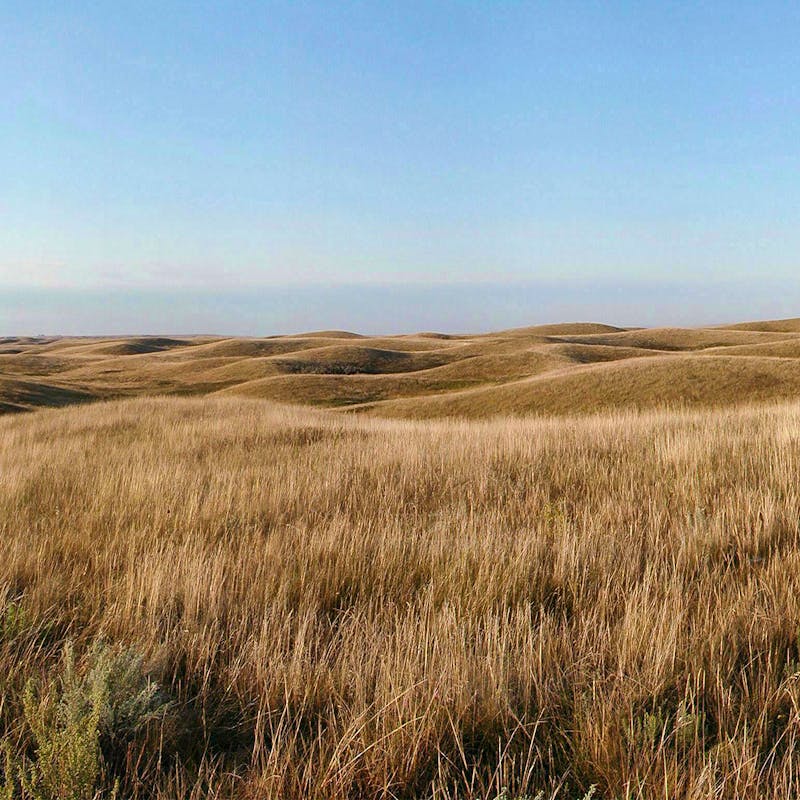There was a quiet buzzing, almost like a swarm of bees making their way across the grasslands. It was not bees though, but rather a drone flying above a prairie dog town, mapping active prairie dog burrows for conservation. Then field technicians drive ATVs on the ground and use a special device to distribute ingestible baits filled with a vaccine developed to help protect prairie dogs against sylvatic plague, a disease that threatens the survival of prairie dogs and endangered black-footed ferrets. Only about 300 black-footed ferrets remain in the wild.
This type of technology may not be the first thing that comes to mind when we talk about saving endangered species. But academic and government researchers have partnered with the U.S. Fish and Wildlife Service and conservation groups, including Defenders of Wildlife, to implement new tools to protect the prairie ecosystem. The ways biologists, acting as pseudo engineers, are creating high-tech solutions to save ferrets and prairie dogs from the devastating sylvatic plague is one of the most fascinating and inspiring parts of our collective recovery efforts.
The Problem: Prairie Dogs and Plague
Protecting prairie dogs is one of the biggest challenges we have encountered as we work to restore the highly endangered black-footed ferret back to our grasslands. Especially since prairie dogs are the ferret’s primary prey and their underground burrows provide important habitat for ferrets and other animals. Unfortunately, prairie dog populations have not only been impacted by plague but also poisoning and recreational shooting.
Plague arrived in the early 1900s on the western shores of North America, with rats as the likely culprit spreading the disease, and around the same time prairie dog poisoning campaigns began ramping up across the West. Together, the threats greatly impacted prairie dog populations across the plains. Today, the prairie dog’s historic range has shrunk to less than 5% making it difficult to recover ferrets back to our grasslands.
Vaccines for Ferrets
For the last several years our recovery efforts have been two steps forward and three steps back. Despite having the plague vaccine in our toolbox, all it takes is the right environmental conditions for plague to pop up. It will then spread like wildfire wiping out entire prairie dog colonies in a matter of days. Then, as we too often experience, the ferrets follow the prairie dogs with their population quickly “blinking out.”
Years ago, to solve this quandary researchers came up with an injectable vaccine for ferrets and an oral vaccine for prairie dogs. On each ferret recovery site, we routinely trap wild-born ferrets to administer the plague vaccine. We also conduct health checks and microchip the animals to document their survival and the recruitment of kits into the population.
It is impossible to trap individual prairie dogs like we do ferrets. After years of trials, however, it seems technology — and creative ways for getting animals to take their medicine — is winning! Today’s tools and methods to administer the plague vaccine are allowing us to finally make some significant strides to protect prairie dogs and ferrets against the disease.
FipBits
Research on prairie dogs and the impact of plague vectored by fleas has been largely guided by U.S. Geological Survey biologists, namely Dr. Dean Biggins and Dr. David Edds. For years they have studied the impacts of plague on prairie dogs. Their research findings have significantly advanced efforts to address plague in the prairie dog ecosystem.
One new technology getting a lot of buzz are Fipronil Baits, affectionately known as “FipBits.” These are tasty treats — to prairie dogs at least — designed as ingestible baits containing small amounts of fipronil. Fipronil is the same active ingredient in FrontLine spray used to kill fleas and ticks on domestic pets and is effective in killing the fleas that spread plague.
FipBits were invented by renowned ferret expert, FWS Supervisory Wildlife Biologist Randy Matchett. “Chef Matchett,” as we call him, has worked tirelessly in his own kitchen to perfect the bait and dosage of this now proven effective flea control method. He worked for years with the Environmental Protection Agency on all the protocols for creating and administering the bait and with many colleagues conducted extensive testing. He was then directed to gain approval of the Federal Drug Administration because it was deemed an “ingestible” drug for the animals and not a pesticide. Today our ferret recovery community is working to use this new tool on prairie dog colonies to prevent plague.
The Triple-shooter Deliver System
Both FipBits and Sylvatic Plague Vaccine — the ingestible plague vaccine for prairie dogs — are distributed via a “triple-shooter” delivery system. This innovation was created by Matchett and a friend with extensive electronic experience. The triple-shooter is mounted on the front of an ATV. As we drive the ATV along straight lines, three baits are distributed along three transects simultaneously in a 30-foot-by-30-foot grid pattern. The triple-shooter is effective in covering large areas of prairie dog town delivering 50 baits per acre, at a rate of treating 40 to 50 acres per hour.
Delta-Dust
The most used plague mitigation tool in the field, and one particularly useful in stopping the spread of plague, is deltamethrin or “Delta-Dust.” This insecticide reduces the spread of plague by killing fleas that spread the disease. It requires long field days, walking or driving an ATV across the prairie and using dusters to spray the dust in every prairie dog burrow on a designated black-footed ferret recovery site. Every time a prairie dog goes in and out of its hole, it rubs up against the Delta-Dust, killing any fleas and tracking the dust throughout the burrow system.
For the first time in years, there is hope we can get ahead of the sylvatic plague, the disease that has long devastated the prairie ecosystem. It’s inspiring to see dedicated ferret and prairie dog experts’ research, cutting-edge science and, in Matchett’s case, old school engineering to create new plague mitigation tools. And these tools are making a difference toward protecting prairie dogs and giving black-footed ferrets a chance to once again flourish on our prairie grasslands.














